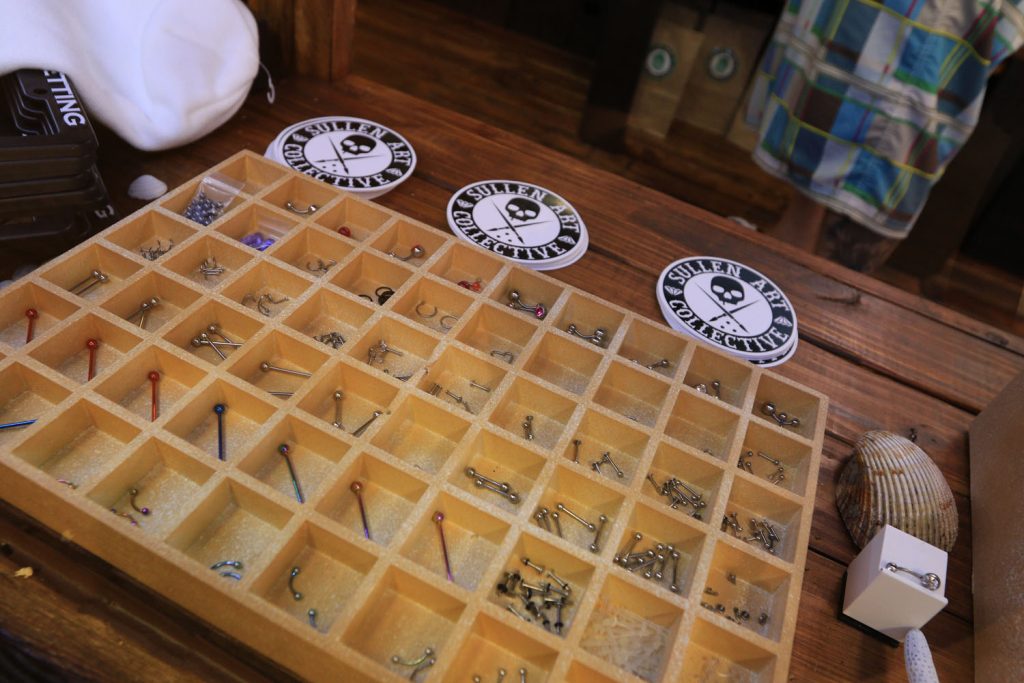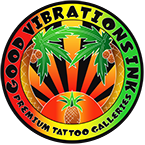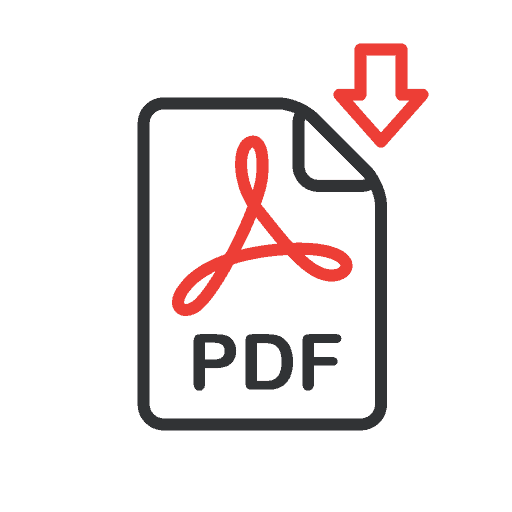PIERCING AFTERCARE INFORMATION

Getting a piercing is a fun and exciting experience. Some people plan out their piercings, while others decide on a spur of the moment. No matter your path, taking proper care of your new piercing is the key to successful healing! Below are some tips and tricks for all piercings. Please read carefully and make sure you follow these instructions appropriately. If you have an ORAL PIERCING, continue reading to find your specific instructions.
BODY PIERCING AFTERCARE:
To keep your body piercing clean, here is what you should do:
Every piercing is a little different but in the big picture, most importantly, keep it clean! We cannot stress to you enough on how important it is to keep your piercing clean and free of bacteria. Anytime you have an open wound, you are susceptible to bacteria, virus and fungus.
First things first: Always WASH your hands thoroughly prior to cleaning or touching your piercing for any reason. Touching your piercing with dirty hands is literally the worst thing you can do for your piercing. You risk exposing it to all kinds of germs and bacteria that will harm your piercing and not allow it to heal.
We recommend using a sterile saline solution to clean your piercings before apply an aftercare solution. Do not use shower gel or bar soap to wash your new piercing. Here are instructions on how to properly wash your piercing:
- SOAP up and gently lather around the piercing. Avoid using harsh soaps, or soaps with dyes or fragrances.
- RINSE thoroughly to remove all traces of the soap from the piercing. It is not necessary to rotate the jewelry through the piercing. This can cause extra trauma to your piercing when it is trying to heal. You may invert a cup of warm water over the area to form a vacuum. This helps rinse without having to jump in the shower every time.
- DRY your piercing by gently patting with clean, disposable paper products. Cloth towels can harbor bacteria and snag on jewelry, causing injury.
To heal your body piercing, here is what you should do:
To heal your piercing, we recommend a couple things. We prefer a packaged sterile saline. This is a gentle choice for piercing aftercare. If sterile saline is not available in your region, a sea salt solution mixture can be a viable alternative. Dissolve 1/4 teaspoon iodine-free, sea salt into one cup (8 oz) of warm distilled or bottled water. A stronger mixture is not better; a saline solution that is too strong can irritate the piercing.
SOAK your new piercing for 5 to 10 minutes, 2 times a day if you are using the saline solution. You can invert a cup of warm saline solution over the area to form a vacuum. For certain piercings it may be easier to apply using clean gauze or paper towels saturated with saline solution.
ORAL PIERCING AFTERCARE:
To keep your oral piercing clean and promote healing, here is what you should do:
Use this remedy for the EXTERIOR CLEANING of your oral piercing:
First things first: Always WASH your hands thoroughly prior to cleaning or touching your piercing for any reason. Touching your piercing with dirty hands is literally the worst thing you can do for your piercing. You risk exposing it to all kinds of germs and bacteria that will harm your piercing and not allow it to heal.
We suggest using soap to clean your piercing prior to applying a non-colored, non-perfumed, anti-bacterial aftercare solution. Here are a few brands of soap we recommend. Do not use shower gel or bar soap to wash your new piercing. Here are instructions on how to properly wash your piercing:
- SOAP up and gently lather around the piercing. Avoid using harsh soaps, or soaps with dyes or fragrances.
- RINSE thoroughly to remove all traces of the soap from the piercing. It is not necessary to rotate the jewelry through the piercing. This can cause extra trauma to your piercing when it is trying to heal. You may invert a cup of warm water over the area to form a vacuum. This helps rinse without having to jump in the shower every time.
- DRY your piercing by gently patting with clean, disposable paper products. Cloth towels can harbor bacteria and snag on jewelry, causing injury.
Use one or both of the following solutions for the INSIDE CLEANING of your mouth: Antimicrobial or antibacterial alcohol-free mouth wash.
- RINSE mouth with cleaning solution for 30 seconds after meals and at bedtime (4-5 times daily) during the entire healing period. Cleaning too often or with too strong a rinse can cause discoloration and irritation of your mouth and piercing.
- SWISH sterile saline solution around in your mouth to promote healing. If sterile saline is not available in your region a sea salt solution mixture can be a viable alternative. Dissolve 1/4 teaspoon iodine-free, sea salt into one cup (8 oz) of warm distilled or bottled water. A stronger mixture is not better; a saline solution that is too strong can irritate the piercing.
- BRUSH your teeth using a new soft-bristled toothbrush and store it in a clean area away from other toothbrushes. Brush your teeth and your tongue after every meal. It is important to floss everyday. Once your oral piercing is healed, brush the jewelry more thoroughly to avoid plaque build up.
GENERAL INFORMATION:
Here is what we consider normal after a body piercing:
Some bleeding, localized swelling, tenderness, or bruising is normal during the initial phase. During the healing process, some discoloration, itching, secretion of a whitish-yellow fluid (not pus) that will form some crust on the jewelry is normal. The tissue may tighten around the jewelry as it heals. This is due to minor swelling.
Some tips and tricks for your new piercing:
- Once your piercing is healed, the jewelry may not move freely in the piercing; do not force it. Some jewelry may fit more snug. If you prefer a looser fit, ask your piercer for a different size.
- If you fail to include cleaning your piercing as part of your daily hygiene routine, normal but smelly bodily secretions may accumulate. This especially occurs with ear piercings.
- A piercing may seem healed before the healing process is complete. This is because tissue heals from the outside in, and although it feels fine, the interior remains fragile. Be patient, and keep cleaning throughout the entire healing period.
- Even healed piercings can shrink or close in minutes after having been there for years! This varies from person to person. If you like your piercing, keep the jewelry in. Do not leave it empty or it will close. Some piercings can start to close within 1 hour of removing the jewelry.
- Stay healthy! The healthier your lifestyle, the easier it will be for your piercing to heal. Get enough sleep and eat a nutritious diet. Exercise during healing is fine; listen to your body.
What you eat and drink can play a huge part in how your body heals. Staying on a healthy diet can drastically improve the process. What you eat can influence how quickly your skin heals after getting a piercing. After getting your new piercing (and following our aftercare instructions) you should focus on nourishing your body with anti-inflammatory food and avoid food that isn’t so healthy. Processed foods lack a ton of essential elements. Consuming lots of fruits and vegetables with omega 3 fatty acids and antioxidants will aid in the healing process. A lot of these foods have anti-inflammatory properties. Most importantly, drink water! Water is essential and you should be drinking plenty of water, whether or not you just got a new piercing. Staying hydrated will prevent your skin from drying up, hence promoting an ideal environment for your body to heal. Avoiding alcohol in large quantities is also recommended since alcohol causes overall inflammation in the body. In plain words, eat clean!
- Make sure your bedding is washed and changed regularly. Wear clean, comfortable, breathable clothing that protects your piercing while you are sleeping.
- Showers tend to be safer than taking baths, as bathtubs can harbor bacteria. If you bathe in a tub, clean it well before each use and rinse off your piercing when you get out.
- Unless there is a problem with the size, style, or material of the initial jewelry, leave it in the place for the entire healing period. See a qualified piercer to perform any jewelry change that becomes necessary during healing.
- Contact your piercer if your jewelry must be removed (such as for a medical procedure). There are non-metallic jewelry alternatives available for short term use.
- Should you decide you no longer want the piercing, simply remove the jewelry, or have a professional piercer remove it. Continue cleaning the piercing until the hole closes. In most cases only a small mark will remain.
Here is what you should avoid with your new piercing:
- Avoid moving jewelry in an unhealed piercing, or picking away dried discharge with your fingers.
- Avoid cleaning with Betadine®, Hibiciens®, alcohol, hydrogen peroxide, Dial® or other soaps containing triclosan, as these can damage cells that are trying to promote good healing. Also avoid ointments as they prevent necessary air circulation and can trap bacteria.
- Avoid Bactine®, pierced ear care solutions and other products containing Benzalkonium Chloride (BZK). These can be irritating and are not intended for long term wound care.
- Avoid over-cleaning. This can delay your healing and irritate your piercing.
- Avoid using cotton or q-tips to clean your piercing. These fibers can get wrapped around your jewelry and harbor bacteria, which can cause infection.
- Avoid undue trauma such as friction from clothing, excessive motion of the area, playing with the jewelry, and vigorous cleaning. These activities can cause the formation of unsightly and uncomfortable scar tissue, migration, prolonged healing, and other complications.
- Avoid all oral contact, rough play, and contact on or near your piercing during healing.
- Avoid stress and recreational drug use, including excessive caffeine, nicotine, and alcohol.
- Avoid submerging the piercing in water such as lakes, pools or hot tubs. You can always protect your piercing using a waterproof wound-sealant bandage. These are available at most drugstores.
- Avoid all beauty and personal care products on or around the piercing including cosmetics, lotions, and sprays, etc.
- Don’t hang charms or any object from your jewelry until the piercing is fully healed.
Here is the sum of it all:
Piercings are a fun and unique way to define yourself without being as permanent as a tattoo. With all that being said, getting a piercing is a great experience, whether it’s your 1st or your 10th! Aftercare plays a huge part in the aftermath of the health of your piercing. At Good Vibrations Ink we highly encourage our customers and clients to really understand the meaning of good aftercare. We want your piercings to stay beautiful for as long as possible and that means being aware of all of the instructions we just discussed. Body piercing is a form of art, don’t be care-less and follow our aftercare instructions for the best results. You may always contact our shop with any questions you may have. Thanks for reading and enjoy your new piercing!

